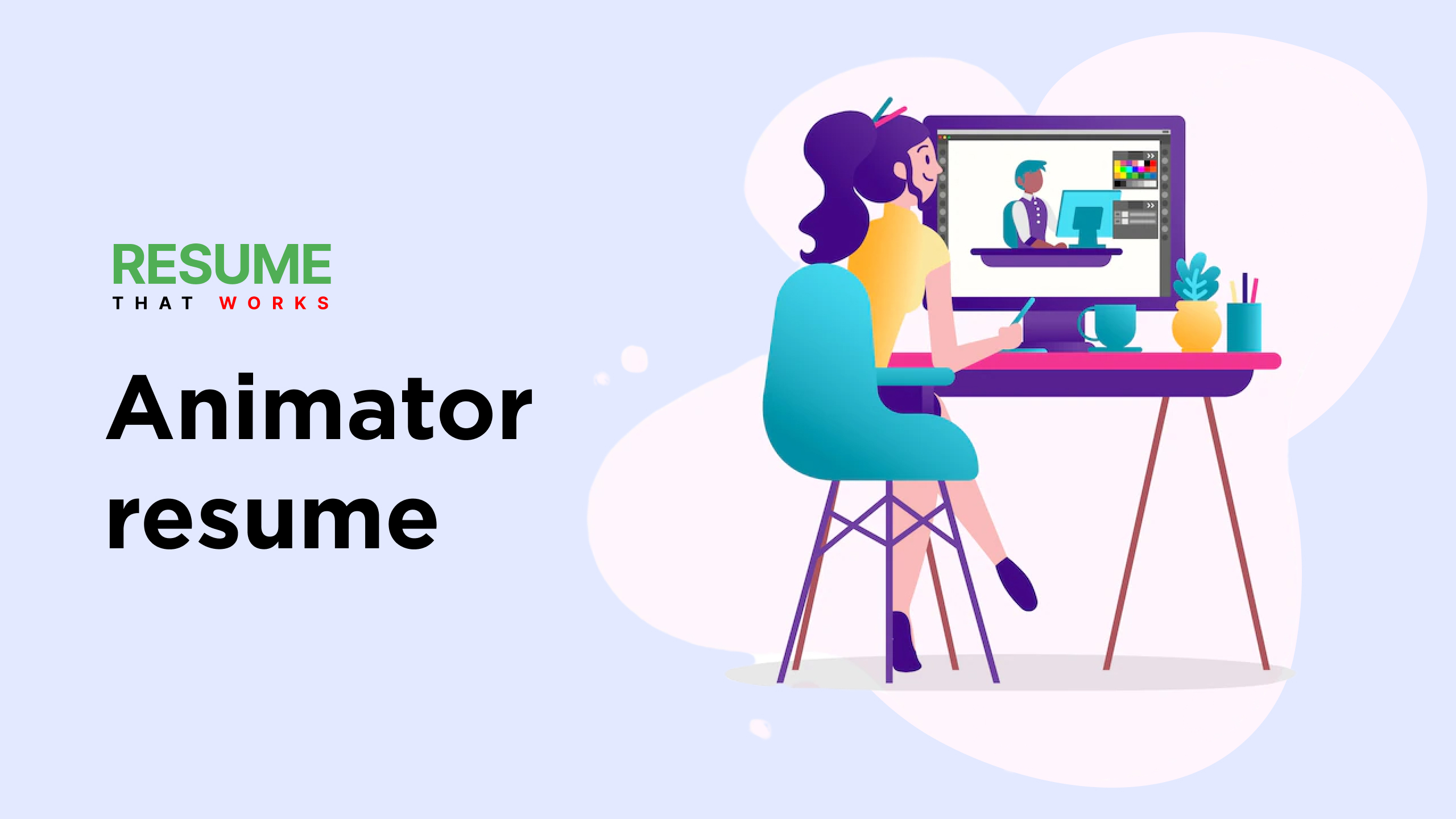Animations are at the core of modern video and image concepts. People love to see animated movies and even explainers and tutorials become much more effective and interesting. The industry needs more professionals which is a piece of good news for a seasoned animator and 3D motion designer like you.
The reality is a little different. Instead of simply sharing a link to their portfolio, professionals need to come up with a resume to showcase their capabilities and highlight their candidature. It is a document that summarizes and highlights a person’s work and academic history and aspirations regarding a position.
In this blog, we will take a look at the 3D animator position, the required skills, and a detailed guide on how to write a winning resume for the position.
Who Is A 3D Animator?
A 3D animator is a professional who manipulates digital characters and makes them interact with their environment. In other terms, they breathe life into their characters and make them come alive by following the scripts or storyboards. The animator’s job is to bring to life the imaginary world and the characters inside it. The main unit of measurement is the frame which becomes three-dimension through the masterful use of graphics and animations.
The role and responsibilities of an animator that must find a place in a resume are as follows:
- Making 3D-rigged models come to life
- Researching and experimenting with the tools to infuse life into the projects
- Implementing motion capture to improve end products
- Highlighting key scenes and sequences in the movies
- Turning static storyboards into dynamic sequences
- Managing libraries of animations and complying with documentation
- Bridging the gaps in sound and dialogue of the movie
Either all or some can help the recruiters see the potential in the professionals and pave their way for the interview.
Skills In Demand For Animators
When we take a look at roles, there is a steep divide between technical and creative roles. Then, some are between these two extremes. It is where the professionals are supposed to be creative and technical at the same time.
When it comes to film and game studios and their demands, the following are the skills that are appreciated in the resumes:
- Good eye for editing and value addition through movement
- Extensive experience with 3D models and rigs
- Visualizing two-dimensional storyboards in three dimensions
- Complete command of acting, cinematography, art, and direction techniques
- Basic understanding of anatomy and behavior of muscles and skin under a weight
- Knowledge and working capacity with different film genres
- Ability to implement the laws of physics to the 3D objects
Planning & Writing The Best Animator Resume
Now that we have cleared the foundations of the role with the job responsibilities and the in-demand skills, it is time to move on to the main part of the blog. Resume writing is both technical and artistic, just like the animator’s work. There is a definitive value in adding and optimizing several sections, but there are many things that are artistic and hard to explain in rational terms.
With that in mind, let us go through the process of writing a good resume for animators.
-
Structure
The structure is the key to a resume. When planning the resume for a dream role in a company, it is best to understand the culture and thinking of that entity. The best thing to do is by going to their website and get an idea of color and design. Then, use those ideas in the structure of your resume. Start with the margins. Both vertical and horizontal margins should be one inch. Then, there are font sizes and styles. You can choose the ones that are visually close to the ones on their websites. In the end, the overall look and feel of the resume should look like it is another leaf from their style book.
-
Objectives Or Experience Summary
This is the section that is mostly read out by recruiters and headhunters. Since they have only a couple of seconds to shortlist resumes based on their merits, this section can provide a summary or an overview. There are different angles to this side. The objective summary is written by professionals with little practical experience in the field. This shows their aspirations to learn and master the craft. For the experience summary, it is best to highlight the responsibilities of the past and the achievements to cement candidacy. There is no way around this section because you need to produce a good section with the message.
-
Job Descriptions
There are two job descriptions that professionals are concerned with. One is the description of the role in the new company. The other is the job descriptions of past experiences. In this section of the resume, professionals need to be clinical and precise but creative and forthcoming enough to convince the recruiters and hiring managers that they can do the job because this is what they have been doing for a long time. The format of giving out that information is simple. Mention the designation and the time that you served in that position. In the description section, make sure to relate the job description of the past with that of the present.
-
Academic Qualifications
Animators are often self-taught or apprenticed by professionals. In most cases, they don’t have relevant degrees and diplomas to show for this section in the resume. However, if they do, they can make the best of this part of the CV by mentioning the name of the degree, the school where they attended classes, and the time of the degree. This is mostly helpful to those who are yet to graduate or just graduated from college and need a place at a competitive company. Keep in mind that academic credentials that are not directly related to this field are best left out of the resume.
-
Special Skills
Special skills are the capabilities of the candidates that are not directly asked in the description but can add value to the whole proposition. For instance, if they have asked for an animator who knows how to work in Unity, but the candidate is not only proficient in that specific program, but a handful of others. This is a feather in the cap of the aspirant that must be highlighted. Also, soft skills or people skills should be mentioned in this section with zeal and vigor.
-
Additional Sections
Many experts believe that additional sections should be scrapped from the resumes. They are true to some extent but it is best to populate it with relevant items. This starts with showcasing skills and vocations that make a person a desirable employee. Things include foreign languages, knowledge of literature, and so on. Again, the idea here is, to sum up, the narrative on a high note. If that is not the case, it is best to cut the section out of the resume.
Writing A Cover Letter
A cover letter is a document that describes the background of a candidate to the recruiters, his experience, and skillset, and then his aspirations to serve in that particular company. Since resumes suffer from the issue of limited space and sections, a cover letter can make leaps in terms of literary ideas and prose. While applying for a job, professional animators should consider writing a cover letter for the job. Even when the recruiters haven’t asked for one, it pays to attach a well-researched and superbly-composed cover letter with the resume. This will help you make your resume stand out from the rest of the competition.
FAQ
How do I make an animator resume?
The template and format of resumes have not changed since. Animators can also go that route. But we have also seen the rise of resumes made on Figma and other graphic designing applications. They are great for animators because they show that professionals are indeed invested in the trade.
What are the duties and responsibilities of an animator?
The roles and responsibilities of an animator can differ from one organization to another, or from one project to another. But the core responsibilities or demands of the role remain the same. These include, but are not limited to, lifelike 3-D rigged models, research, and experiments for better execution of ideas. The most important one covers turning two-dimensional storyboards into 3-D content.
How do I make an artistic resume?
There are many ways to make an artistic resume. The most important thing in that pursuit is to abandon the classical tools of writing and creating. If you are interested in making a resume that can be considered the pinnacle of art, you need to get the tools of animations and then use them to create lively sections of your resume.
How do you make a 3D model resume?
A 3-D model professional works within a virtual environment to create objects with depth and scope. In this scenario, the resume of that professional should highlight his prowess and acumen regarding the job. They are in high demand in the film and gaming industries and that’s where they should look for the best opportunities.
What skills do animators need?
The list of skills that animators can benefit from covers filmography, editing, and the creation of stories. The most important skill that animators should learn and hone is to tell a story with weight and dimensions. If the story is flat because of its flat projection, it is a lost opportunity for everyone.
What skills would an animator need?
There are many skills that animators need to master if they want to make a big difference in their fields. The most common include mastery of applications to design and develop three-dimensional worlds and figures. Also, the art of learning different genres and telling stories accordingly should be at the top of their lists. When it comes to soft skills, the list covers people skills, teamwork, and leadership capabilities.




